|
Hertfordshire Post Card History The Undivided back Until 1902 |
|
Hertfordshire Post Card History The Undivided back Until 1902 |
|
The earliest UK postcards were issued in 1870. These were plain, sold at a ½d each - with the stamp already embossed on the address side, leaving the other side blank for a message. Commercial firms could buy in bulk and print their own information on the blank side, but there were no picture post cards as we know them. |
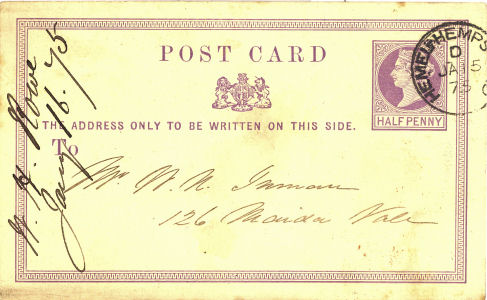 |
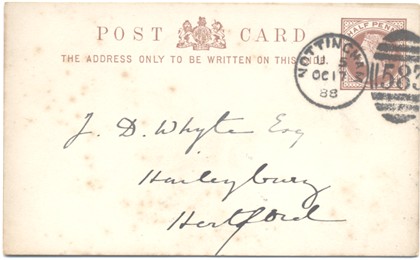
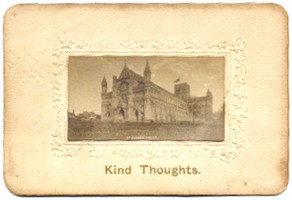 |
In addition picture cards were becoming available which could be sent in envelopes, such as this "Kind Thoughts" card of St Albans Abbey from about 1890. |
In 1895 the law was changed to allow a normal stamp to be affixed to a card, but the breakthrough was in 1899 when the standard sized card 5½ by 3½ inches was introduced, but it was still not possible to have the picture, or the message, on the address side of the card. The earliest picture postcards were therefore published with blank space on the picture side - so that a message could be written next to the picture. The address side usually carried the words "The address only to be written only on this side" or similar. Postage was ½d inland and 1d overseas. Initially the publisher information had to be on the picture side.
Example 1 - Multiview of St Albans - 1900
 |
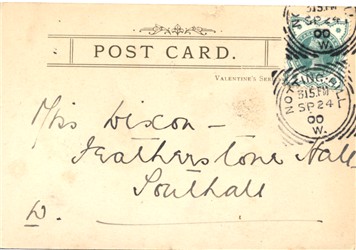 |
This is one of the early cards published by Valentine & Sons, and is an attractive multi-view card of a smaller size than the standard sized postcard introduced in 1899. It has three views of the cathedral and one of the clock tower, together with the city arms and some attractive framing. It was posted in 1900.
Example 2 - St Albans Abbey - 1901
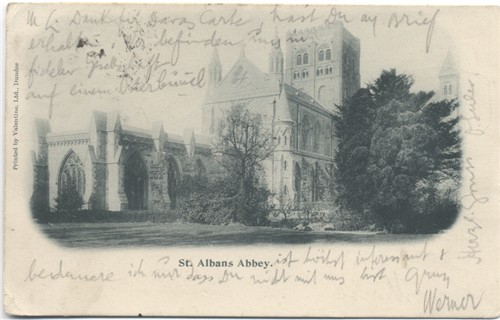
This is a view of the Abbey from the North East and appears to be from the same photograph as the picture on the earlier multi-view card shown above. It was posted in April 1901, with a 1d Queen Victoria stamp, and was sent overseas - where it was repeatedly re-directed. The message was written in German, round the picture. The card is identified by "Printed by Valentine Ltd, Dundee". Valentine Ltd was one of the earliest picture postcard publishers. Significantly the publisher information is on the picture side, as initially such information was not allowed on the address side of the card

Example 3 - Broxbourne Church
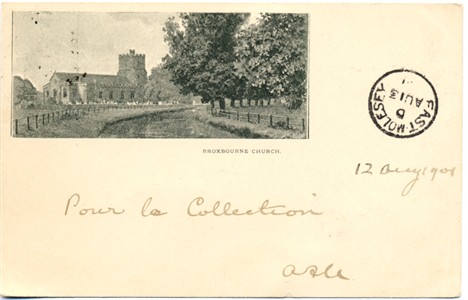
A simple early card, publisher unknown, with plenty of space for the message on the picture side, and posted in August 1901.

Example 4 - St Albans Abbey - 1903
Another early card showing the Abbey from the South West. It was posted to the USA in March 1903 and has two ½d King Edward VII stamps. The card is numbered 1905 and the address side says "Post Card - Great Britain and Ireland" as well as "The address only to be written on this side". The distinctive wording and form of this message suggests it was published by the pioneer postcard publishers Blum & Degan Ltd, and the number suggests it may have been published by early 1901.
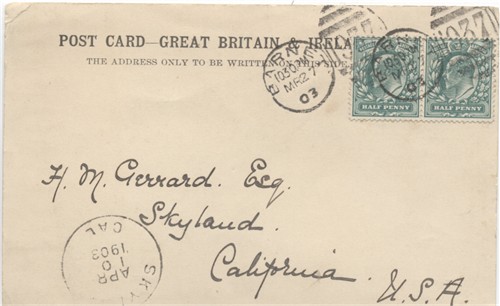
Addressed to: H. M. Gerrard, Esq., Skyland, California, USA.
Message: 6 The Avenue, Barnet, Herts, 27.3.03. Have secured a cottage in every way most satisfactory at Wheathampstead. They have quite turned round & are delighted with it. This was the first of three answers from our advert. Much Love, A. E. G.
Example 5 - Early Postage Rates

Many of the cards recorded the postal rate in the "stamp box". This example came from an unused early card published by "Stengel & Co., London E.C. 39 Redcross Street printed at Works, Dresden," number 19381. The picture is of St Albans Abbey (from a similar position to the previous picture). Stengel published view and other postcards in the UK from 1901.
Example 6 - Hitchin - 1902
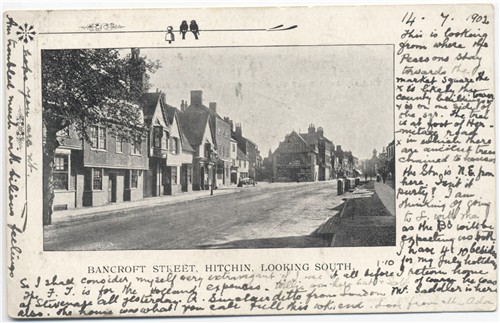
This card has a very attractive design and shows how the text could be packed in. It was posted to Holland in July 1902, with a 1d Edward VII stamp. Unfortunately the publisher is not named.
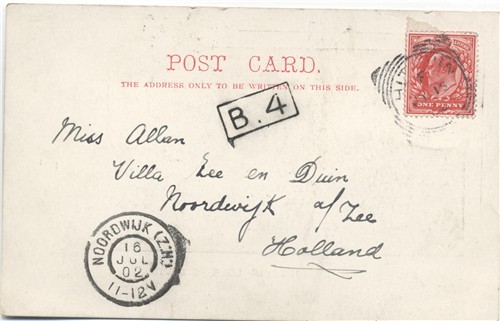
I have a second example of this card, with identical picture and back, but without the printed decoration, posted in October 1902. By moving the picture up and to the left more space has been provided for the message.
Example 7 - Cheshunt Church - Early
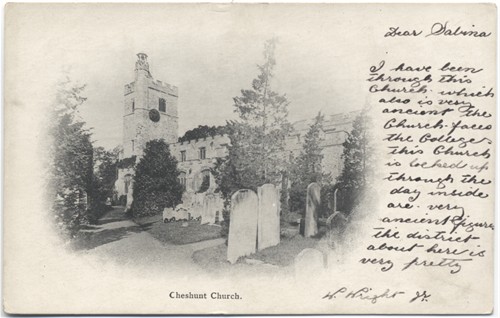
Undated (the address side has not been used) but clearly early. No publisher information.
Example 8 - Watford Church - Fig Tree - 1904 or earlier
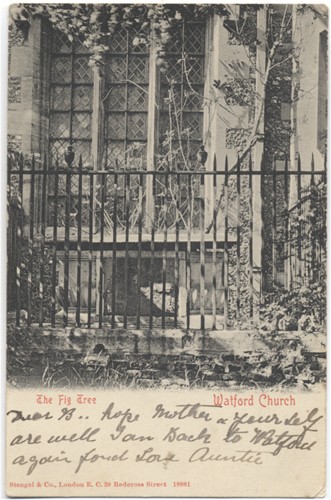
A card by "Stengel & Co., London E.C. 39 Redcross Street printed at Works, Dresden," showing the fig tree growing out of a tomb in Watford Church Yard. It is numbered 18881 and was posted in June 1904.
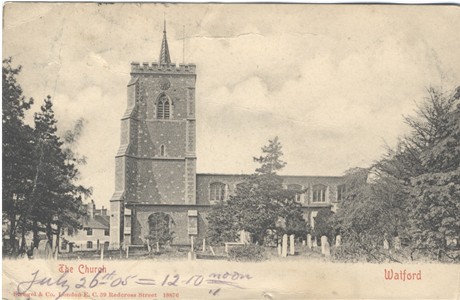
The publisher numbers used can be a clue to the relative dates of cards. The card of the Fig Tree was probably published at the same time as the above postcard of Watford Church which has the number 18876 (but the copy I have was posted in July 1905), while the St Albans card (example 5, above) number 19381was presumably published a bit later. The two Watford cards both have the publisher information on the picture side, while the similarly styled St Albans card has the publisher information on the address side - again suggesting that the Watford cards are older.
Example 9 - A manually divided card
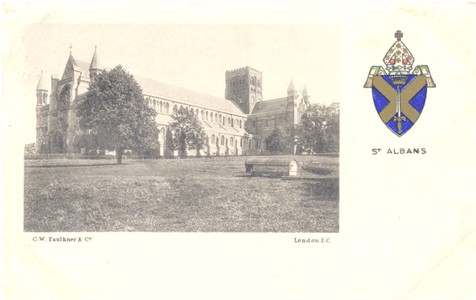
A version of this card, with text on the picture side, is known from 1903.
When the regulations changed there would have been a lot of stock with undivided backs for sale, or in production but this did not stop the purchaser from dividing the back themselves. This C. W. Faulkner card, with undivided address side and space on the picture side for a message , was neatly "divided" by Bert when he sent the card to Miss J. Nightingale in 1904. The publisher also responded to the change and reissued the card in a completely new format (q.v,).
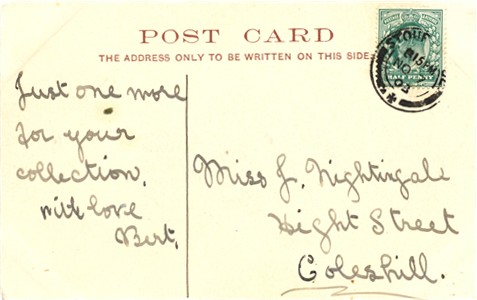
If you can add to the information given above tell me.
Page updated October 2005